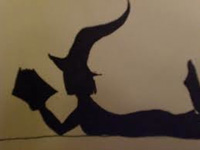 “Double, double toil and trouble; Fire burn, and cauldron bubble” is Shakespeare’s oft quoted line from Macbeth frequently heard this time of year. It sets the literary tone for the selection of books reviewed this week by the International Reading Association Children’s Literature and Reading Special Interest Group. Children love scary stories and the thrill and chill of not knowing what will happen next. Scary stories can be funny or poetic or exciting, but every year new books come out to offer these safe scares for readers everywhere. As children grow into adult readers the Mystery/Thriller genre continues to be one of the most popular, so teachers can initiate the life-long reading journey with some of the new titles and ideas suggested this week.
“Double, double toil and trouble; Fire burn, and cauldron bubble” is Shakespeare’s oft quoted line from Macbeth frequently heard this time of year. It sets the literary tone for the selection of books reviewed this week by the International Reading Association Children’s Literature and Reading Special Interest Group. Children love scary stories and the thrill and chill of not knowing what will happen next. Scary stories can be funny or poetic or exciting, but every year new books come out to offer these safe scares for readers everywhere. As children grow into adult readers the Mystery/Thriller genre continues to be one of the most popular, so teachers can initiate the life-long reading journey with some of the new titles and ideas suggested this week.
ReadWriteThink offers podcasts about scary stories in Chat About Books or for older readers try “Thrills! Chills! Using Scary Stories to Motivate Students to Read.”
GRADES K-3
Bauer, Marion Dane. (2012). Halloween forest. Illus. by John Shelley. New York: Holiday House.
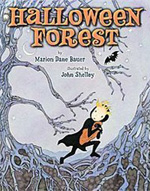 It’s Halloween night, and a brave trick-or-treater heads off to gather sweet loot. Along the way, he faces a most frightening collection of bones in the forest. Undaunted and determined, he marches through the book’s pages all the way up to a bone-laden house and demands and receives a mother lode of candy. Some of the pen-and-India ink and watercolor illustrations are particularly spooky, especially the one in which the forest's limbs turn into the fingers and arms of human skeletons and reach out to him, and even the roof thatch of the house he finds in the heart of the forest is formed from bones. Since the boy never seems to be frightened by the threatening forest, things turn out okay. While walking unconcernedly through a dark forest might not be recommended, sometimes facing fears leads to bountiful rewards, making the effort worthwhile.
It’s Halloween night, and a brave trick-or-treater heads off to gather sweet loot. Along the way, he faces a most frightening collection of bones in the forest. Undaunted and determined, he marches through the book’s pages all the way up to a bone-laden house and demands and receives a mother lode of candy. Some of the pen-and-India ink and watercolor illustrations are particularly spooky, especially the one in which the forest's limbs turn into the fingers and arms of human skeletons and reach out to him, and even the roof thatch of the house he finds in the heart of the forest is formed from bones. Since the boy never seems to be frightened by the threatening forest, things turn out okay. While walking unconcernedly through a dark forest might not be recommended, sometimes facing fears leads to bountiful rewards, making the effort worthwhile.
- Barbara A. Ward, Washington State University Pullman
Bracegirdle, P. J. (2012). The dead family Diaz. Illus. by Poly Bernatene. New York: Dial Books for Young Readers.
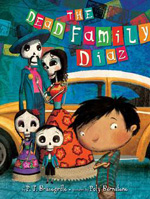 Angelito is nervously excited about celebrating El Dia de los Muertes as he travels with his family, the Dead Familia Diaz, into the Land of the Living on the night of this eerie holiday. He has told no one that he is actually scared of meeting an actual living person with their pale and squishy skin. On the night of the festival he gets separated from his family. As he fearfully looks around at the loud and colorful festivities he runs into Pablo (who is wearing a skeleton mask.) The two boys shyly admit to their fears and together move on into frolic of the evening’s entertainment and have so much fun! As the evening comes to a close and Angelito finds his family, illustrator Beratene creates a double page spread to show the shock and realization of the two boys as they discover whom they really are. With this realization comes the understanding that being different isn’t necessarily a bad thing or something to be feared. When the story closes each boy is looking forward to next year’s celebration. Enjoy the author’s website or follow the author on Facebook. ReadWriteThink offers a lesson idea entitled “Collaborating on a Class Book: Exploring Before-During-After Sequences.”
Angelito is nervously excited about celebrating El Dia de los Muertes as he travels with his family, the Dead Familia Diaz, into the Land of the Living on the night of this eerie holiday. He has told no one that he is actually scared of meeting an actual living person with their pale and squishy skin. On the night of the festival he gets separated from his family. As he fearfully looks around at the loud and colorful festivities he runs into Pablo (who is wearing a skeleton mask.) The two boys shyly admit to their fears and together move on into frolic of the evening’s entertainment and have so much fun! As the evening comes to a close and Angelito finds his family, illustrator Beratene creates a double page spread to show the shock and realization of the two boys as they discover whom they really are. With this realization comes the understanding that being different isn’t necessarily a bad thing or something to be feared. When the story closes each boy is looking forward to next year’s celebration. Enjoy the author’s website or follow the author on Facebook. ReadWriteThink offers a lesson idea entitled “Collaborating on a Class Book: Exploring Before-During-After Sequences.”
- Karen Hildebrand, Ohio Library and Reading Consultant
Bullard, Lisa. (2012). Daniela’s Day of the Dead. Illus. by Holli Conger. Minneapolis: Lerner/Millbrook Press.
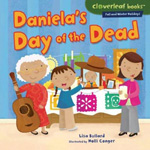 In four short chapters (“Waiting for Day of the Dead,” “An Altar for Grandpa,” “At the Market,” and “Celebrating!”), the author provides introductory information about Day of the Dead, a holiday with which many youngsters may not be as familiar as they are with Halloween, Christmas, and Hanukkah. Daniela explains how her ancestors brought the traditions of this day intended to celebrate, not mourn, the dead to their home in the United States from their homes in Mexico. She describes filling an altar with his favorite objects in honor of her grandfather, shopping for sugar skulls and funny skeletons, buying and eating bread with tiny toy skeletons tucked inside, and honoring the dead by visiting their graves. Back matter includes a glossary, website and book suggestions to learn more, and directions for making a skeleton from macaroni. The illustrations are filled with bright colors and smiling faces, all enabling young readers to regard the holiday, celebrated on November 2 in the United States, in a positive light. As young readers are reminded in the text, death is simply a part of life and not necessarily something scary.
In four short chapters (“Waiting for Day of the Dead,” “An Altar for Grandpa,” “At the Market,” and “Celebrating!”), the author provides introductory information about Day of the Dead, a holiday with which many youngsters may not be as familiar as they are with Halloween, Christmas, and Hanukkah. Daniela explains how her ancestors brought the traditions of this day intended to celebrate, not mourn, the dead to their home in the United States from their homes in Mexico. She describes filling an altar with his favorite objects in honor of her grandfather, shopping for sugar skulls and funny skeletons, buying and eating bread with tiny toy skeletons tucked inside, and honoring the dead by visiting their graves. Back matter includes a glossary, website and book suggestions to learn more, and directions for making a skeleton from macaroni. The illustrations are filled with bright colors and smiling faces, all enabling young readers to regard the holiday, celebrated on November 2 in the United States, in a positive light. As young readers are reminded in the text, death is simply a part of life and not necessarily something scary.
- Barbara A. Ward, Washington State University Pullman
Catrow, David. (2012). Monster mash. New York: Orchard Books.
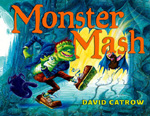 Catrow has reimagined the song lyrics to the popular 1962 classic song, “The Monster Mash” written by Bobby “Boris” Pickett and Lenny Capizzi. Using watercolors, gouache, and pen and pencil Catrow has created a cast of monsters that young readers will love. Though the text is scant and simple as the words dance through the song lyrics, the illustrations are so much fun and children will love pouring over each page looking at the details and action including the monsters drawn right into the title on the title page where the fun begins. The story/song opens with a scientist “working in the lab late one night” (page 1) and the monsters begin to appear everywhere. Zombies, Wolf Man, Dracula (and his son!), ghouls, vampires, are dancing and creating mayhem throughout the castle. When the coffin-bangers and their vocal group The Crypt-Kicker Five show up the mash gets even more rollicking. Adults reading this book will immediately begin to hear the song in their heads and will probably develop a rhythm to reading this book aloud. Young readers will enjoy viewing and listening to the original song and animated version of the Monster Mash. Perfect for a classroom Halloween party! Learn more about this author/illustrator at his website and blog.
Catrow has reimagined the song lyrics to the popular 1962 classic song, “The Monster Mash” written by Bobby “Boris” Pickett and Lenny Capizzi. Using watercolors, gouache, and pen and pencil Catrow has created a cast of monsters that young readers will love. Though the text is scant and simple as the words dance through the song lyrics, the illustrations are so much fun and children will love pouring over each page looking at the details and action including the monsters drawn right into the title on the title page where the fun begins. The story/song opens with a scientist “working in the lab late one night” (page 1) and the monsters begin to appear everywhere. Zombies, Wolf Man, Dracula (and his son!), ghouls, vampires, are dancing and creating mayhem throughout the castle. When the coffin-bangers and their vocal group The Crypt-Kicker Five show up the mash gets even more rollicking. Adults reading this book will immediately begin to hear the song in their heads and will probably develop a rhythm to reading this book aloud. Young readers will enjoy viewing and listening to the original song and animated version of the Monster Mash. Perfect for a classroom Halloween party! Learn more about this author/illustrator at his website and blog.
- Karen Hildebrand, Ohio Library and Reading Consultant
Hiti, Samuel. (2012). Waga’s big scare. Minneapolis, MN: Carolrhoda Books/Lerner Publishing Group.
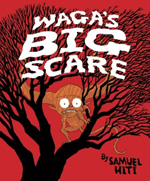 Waga might be small, but Waga is a terrifyingly mean and nasty little monster that has the biggest scare. When Waga discovers that Waga’s scare is gone, the story takes off in a series of scenes where Waga is desperately trying to find the scare. Waga must find the square before sunrise or Waga will disappear forever. Hiti comes to the picture book genre by way of his comic book career, so Waga has a fierce cartoon-like appearance. Pictures in bold red and black add to the scare factor in this book, but as Waga goes in search of the scare the action takes a bit of a silly turn. Waga searches the monster parade and the creepy forest, dark caves, every nook and cranny in the graveyard, and then squeezes through drain pipes, creeps down the hallway until Waga finds the scare under YOUR bed! This will be fun for reading aloud. Author/illustrator Sam Hiti has an active website, blog, and tumblr posts. If you are looking for a simple white board interactive or a computer lab activity, students will enjoy Scholastic’s Monster Maker site.
Waga might be small, but Waga is a terrifyingly mean and nasty little monster that has the biggest scare. When Waga discovers that Waga’s scare is gone, the story takes off in a series of scenes where Waga is desperately trying to find the scare. Waga must find the square before sunrise or Waga will disappear forever. Hiti comes to the picture book genre by way of his comic book career, so Waga has a fierce cartoon-like appearance. Pictures in bold red and black add to the scare factor in this book, but as Waga goes in search of the scare the action takes a bit of a silly turn. Waga searches the monster parade and the creepy forest, dark caves, every nook and cranny in the graveyard, and then squeezes through drain pipes, creeps down the hallway until Waga finds the scare under YOUR bed! This will be fun for reading aloud. Author/illustrator Sam Hiti has an active website, blog, and tumblr posts. If you are looking for a simple white board interactive or a computer lab activity, students will enjoy Scholastic’s Monster Maker site.
- Karen Hildebrand, Ohio Library and Reading Consultant
Hood, Susan. (2012). Just say boo! Illus. by Jed Henry. New York: Harper.
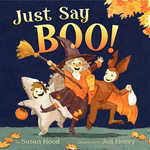 Three children dressed as a vampire bat, a witch, and a shark go trick or treating with their father on Halloween night. Each double page spread places them in different situations throughout the evening as they walk through woods and wind and encounter jack-o-lanterns and ghosts and even friendly neighbors. Each encounter written in rhymed phrases asks the question what would you say or do? Often the answer is “just say boo!” As the evening continues however, the pattern changes a few times and the rhyming answer is sometimes “Ewww” or “Thank you.” Teachers will find this book an excellent read aloud not only for the rhyming nature of the story but also for the writing pattern it presents for teachers to encourage young readers/listeners to try their hand at writing. Muted sepia illustrations give a soft presentation to the storyline. Visit the author’s website for more information and a very fun book trailer featuring young trick or treaters.
Three children dressed as a vampire bat, a witch, and a shark go trick or treating with their father on Halloween night. Each double page spread places them in different situations throughout the evening as they walk through woods and wind and encounter jack-o-lanterns and ghosts and even friendly neighbors. Each encounter written in rhymed phrases asks the question what would you say or do? Often the answer is “just say boo!” As the evening continues however, the pattern changes a few times and the rhyming answer is sometimes “Ewww” or “Thank you.” Teachers will find this book an excellent read aloud not only for the rhyming nature of the story but also for the writing pattern it presents for teachers to encourage young readers/listeners to try their hand at writing. Muted sepia illustrations give a soft presentation to the storyline. Visit the author’s website for more information and a very fun book trailer featuring young trick or treaters.
- Karen Hildebrand, Ohio Library and Reading Consultant
Johnson, J. Angelique. (2012). Making a jack-o’-lantern, step by step. North Mankato, MN: Capstone Press.
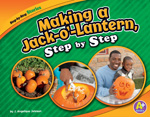 Many primary classrooms visit pumpkin farms during the month of October where students pick out a pumpkin and take it home. This is the perfect nonfiction text for students to read that will help them carve a jack-o’-lantern. The full-page photographs show a family visiting a pumpkin patch, picking the right pumpkin, getting ready to carve, preparing the pumpkin and making the jack-o’-lantern. In addition, most pages contain pumpkin or Halloween facts. Families could follow all of these steps and be ready to showcase their glowing jack-o’-lanterns on Halloween eve. This book would also make a fun read aloud. This book is part of a series with other titles on caring for a pet, recycling, and fighting a fire.
Many primary classrooms visit pumpkin farms during the month of October where students pick out a pumpkin and take it home. This is the perfect nonfiction text for students to read that will help them carve a jack-o’-lantern. The full-page photographs show a family visiting a pumpkin patch, picking the right pumpkin, getting ready to carve, preparing the pumpkin and making the jack-o’-lantern. In addition, most pages contain pumpkin or Halloween facts. Families could follow all of these steps and be ready to showcase their glowing jack-o’-lanterns on Halloween eve. This book would also make a fun read aloud. This book is part of a series with other titles on caring for a pet, recycling, and fighting a fire.
- Deanna Day, Washington State University Vancouver
Lachenmeyer, Nathaniel. (2012). The boo! book. Illus. by Nicoletta Ceccoli. New York: Atheneum Books for Young Readers.
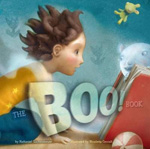 This hauntingly beautiful book may attract more adult admirers than children. The idea behind this book is that books can be haunted just like houses can be haunted. Ghosts may have taken up residence within the pages of the book and do some mischievous things within the pages of the story. The entire storyline is cautionary to warn the reader about the clues that will tell them whether the book is haunted or not. Things like if the book feels cold when you place it near your ear or if you hear something that sounds like a ghost holding its breath and if you discover that the book IS haunted, never read it on the anniversary of the day the ghost arrived in the book or you will be sucked into the book yourself! Other mischievous things that might happen are words suddenly mixed up or characters and plotlines shifting around. The somewhat bizarre illustrations are created with plasticine puppets; acrylic paint and digital photographs that give a surreal look to the pictures. Read about other scary books in ReadWriteThink’s Chatting About Books podcast entitled “Get Spooky with Matthew McElligot.”
This hauntingly beautiful book may attract more adult admirers than children. The idea behind this book is that books can be haunted just like houses can be haunted. Ghosts may have taken up residence within the pages of the book and do some mischievous things within the pages of the story. The entire storyline is cautionary to warn the reader about the clues that will tell them whether the book is haunted or not. Things like if the book feels cold when you place it near your ear or if you hear something that sounds like a ghost holding its breath and if you discover that the book IS haunted, never read it on the anniversary of the day the ghost arrived in the book or you will be sucked into the book yourself! Other mischievous things that might happen are words suddenly mixed up or characters and plotlines shifting around. The somewhat bizarre illustrations are created with plasticine puppets; acrylic paint and digital photographs that give a surreal look to the pictures. Read about other scary books in ReadWriteThink’s Chatting About Books podcast entitled “Get Spooky with Matthew McElligot.”
- Karen Hildebrand, Ohio Library and Reading Consultant
Schuette, Sarah L. (2012). A Halloween cookbook: Simple recipes for kids. North Mankato, MN: Capstone Press.
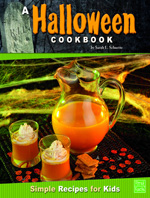 Just like the title says, this book contains easy step-by-step recipes for Halloween. Some of the recipes include jack-o'-lantern juice, eyeball salad, and witch fingernails. Young children will enjoy making these tasty treats at school or at home. Teachers could set up a center where students read the directions and follow the photographs to create a ghoulishly delicious snack. For example after studying spiders, students could make the crunchy spider recipe with chocolate cookies, peanut butter, and pretzel sticks. My five-year-old daughter and I enjoyed making and eating these together. Each recipe contains an ingredient list and tool list to help adults. Implementing cooking teaches literacy, science and math plus it is so much fun!
Just like the title says, this book contains easy step-by-step recipes for Halloween. Some of the recipes include jack-o'-lantern juice, eyeball salad, and witch fingernails. Young children will enjoy making these tasty treats at school or at home. Teachers could set up a center where students read the directions and follow the photographs to create a ghoulishly delicious snack. For example after studying spiders, students could make the crunchy spider recipe with chocolate cookies, peanut butter, and pretzel sticks. My five-year-old daughter and I enjoyed making and eating these together. Each recipe contains an ingredient list and tool list to help adults. Implementing cooking teaches literacy, science and math plus it is so much fun!
- Deanna Day, Washington State University Vancouver
GRADES 4-6
Dahl, Michael. (2012). Hocus pocus hotel. Illus. by Lisa K. Weber. Minneapolis, MN: Capstone.
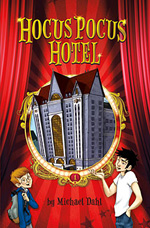 Charlie Hitch Hitchcock is wary about accepting the invitation from school bully Tyler Yu to meet him at the old hotel after school because he is afraid he wants a fight. As it turns out, however, Ty wants Charlie to help him solve the mysteries that are going on at the hotel. It turns out that Tyler lives at the Hocus Pocus Hotel and that it is a retirement hotel for professional magicians. The elderly magicians have something strange going on in room 1413 in addition to disappearance of hotel belongings like shower curtains, spoons, and bowling pins. Strange sounds and shadows flicker through the hotel. Charlie is blessed with acute visual memory and as the boys move through the hotel looking for clues to the disappearances, Charlie’s photographic memory enables them to put all the clues together. While in search of clues they learn a lot about magic and performing magic tricks. The author has included instructions on how to perform these tricks for readers on journal paper throughout the book. A few simple mysteries are solved but they lead to an overarching mystery surrounding the hotel. This is the first in a new series. For readers with smart phones or iPads or teachers with white boards, the QR code on the back cover of the book will lead to more resources for using the book to learn more about magic. The Hocus Pocus Hotel has its own website with many extra fun resources for readers including a video and magic tricks, or find a ReadWriteThink lesson entitled “Celebrate Halloween.”
Charlie Hitch Hitchcock is wary about accepting the invitation from school bully Tyler Yu to meet him at the old hotel after school because he is afraid he wants a fight. As it turns out, however, Ty wants Charlie to help him solve the mysteries that are going on at the hotel. It turns out that Tyler lives at the Hocus Pocus Hotel and that it is a retirement hotel for professional magicians. The elderly magicians have something strange going on in room 1413 in addition to disappearance of hotel belongings like shower curtains, spoons, and bowling pins. Strange sounds and shadows flicker through the hotel. Charlie is blessed with acute visual memory and as the boys move through the hotel looking for clues to the disappearances, Charlie’s photographic memory enables them to put all the clues together. While in search of clues they learn a lot about magic and performing magic tricks. The author has included instructions on how to perform these tricks for readers on journal paper throughout the book. A few simple mysteries are solved but they lead to an overarching mystery surrounding the hotel. This is the first in a new series. For readers with smart phones or iPads or teachers with white boards, the QR code on the back cover of the book will lead to more resources for using the book to learn more about magic. The Hocus Pocus Hotel has its own website with many extra fun resources for readers including a video and magic tricks, or find a ReadWriteThink lesson entitled “Celebrate Halloween.”
- Karen Hildebrand, Ohio Library and Reading Consultant
Fagan, Cary. (2012). The boy in the box. Boston/New York: Houghton Mifflin Harcourt/Clarion.
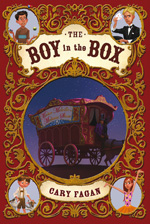 Although eleven-year-old Sullivan Mintz loves to juggle, his parents pay little attention to Sullivan or his hobby. They are preoccupied with running the Stardust Home for Old People, whose residents enjoy chatting with Sullivan. In fact, one of the residents, eighty-one-year-old Manny, is Sullivan’s best friend. Sullivan is the favorite target for Samuel Patinsky, a classmate who relishes relentlessly ridiculing him. When he and his sister Jinny see notices for a traveling medicine show, Sullivan is astonished that the performers are children just like him. He ends up being kidnapped by Master Melville and his wife and joins the other youthful performers who are prisoners of the Melvilles. His parents are left thinking that he has drowned. As Sullivan deals with the cruelty of his keepers, he also bonds with the other children who nurture him and help him hone his juggling skills. Sullivan's determination to juggle and his affection for the elderly charges under his parents' care are admirable, but it’s frightening to think of the Melvilles traveling through the countryside with a band of kidnapped children with no questions being asked as they pass from town to town. Even worse, Sullivan somehow feels as though he has found a place where he belongs despite being imprisoned except during practice time and performance time. Obviously, he will try to run away eventually and return home, but until then, he seems to have chosen the traveling life of a performer being used to sell Master Melville’s special elixir.
Although eleven-year-old Sullivan Mintz loves to juggle, his parents pay little attention to Sullivan or his hobby. They are preoccupied with running the Stardust Home for Old People, whose residents enjoy chatting with Sullivan. In fact, one of the residents, eighty-one-year-old Manny, is Sullivan’s best friend. Sullivan is the favorite target for Samuel Patinsky, a classmate who relishes relentlessly ridiculing him. When he and his sister Jinny see notices for a traveling medicine show, Sullivan is astonished that the performers are children just like him. He ends up being kidnapped by Master Melville and his wife and joins the other youthful performers who are prisoners of the Melvilles. His parents are left thinking that he has drowned. As Sullivan deals with the cruelty of his keepers, he also bonds with the other children who nurture him and help him hone his juggling skills. Sullivan's determination to juggle and his affection for the elderly charges under his parents' care are admirable, but it’s frightening to think of the Melvilles traveling through the countryside with a band of kidnapped children with no questions being asked as they pass from town to town. Even worse, Sullivan somehow feels as though he has found a place where he belongs despite being imprisoned except during practice time and performance time. Obviously, he will try to run away eventually and return home, but until then, he seems to have chosen the traveling life of a performer being used to sell Master Melville’s special elixir.
- Barbara A. Ward, Washington State University Pullman
Hennessy, B. G. (2012). The scary places map book: Seven terrifying tours. Illus. by Erwin Madrid. Somerville, MA: Candlewick.
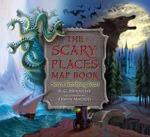 Seven different maps take readers on journeys to some really scary places, enabling them to hone their map reading skills while encountering some downright frightening moments. Based on mythology, one of the tours takes readers to the “Land of Mythical Monsters.” The other map adventures are based on other spooky tales about pirates, vampires, gunslingers, and witches, among others. The author employs clever word play; for instance, readers travel to the “Western Terror-tories" to see what Gruesome Gus has left behind. Other trips include “The Ghostly Galleon Cruise of the Seven Seas,” a “Trip through Transylvania,” a “Tour of the Wicked Woods and Witchfield Village,” a “Sleepwalking Tour of Nightmare House,” and a “Museum of Haunted Objects.” The digital illustrations add an air of spookiness to the already-scary-sounding map titles. Readers will need to read the directions for each map and follow the grids in order to navigate the area, and they’re sure to enjoy going back through the maps again and again in order to skirt disaster. Back matter includes additional challenges as readers are encouraged to return to each map and look for even more details, including ruby slippers and a bloodmobile. While it is helpful if readers are familiar with the stories on which these maps are based, the chills and thrills they experience through this book might prompt them to search for more about their spooky subjects.
Seven different maps take readers on journeys to some really scary places, enabling them to hone their map reading skills while encountering some downright frightening moments. Based on mythology, one of the tours takes readers to the “Land of Mythical Monsters.” The other map adventures are based on other spooky tales about pirates, vampires, gunslingers, and witches, among others. The author employs clever word play; for instance, readers travel to the “Western Terror-tories" to see what Gruesome Gus has left behind. Other trips include “The Ghostly Galleon Cruise of the Seven Seas,” a “Trip through Transylvania,” a “Tour of the Wicked Woods and Witchfield Village,” a “Sleepwalking Tour of Nightmare House,” and a “Museum of Haunted Objects.” The digital illustrations add an air of spookiness to the already-scary-sounding map titles. Readers will need to read the directions for each map and follow the grids in order to navigate the area, and they’re sure to enjoy going back through the maps again and again in order to skirt disaster. Back matter includes additional challenges as readers are encouraged to return to each map and look for even more details, including ruby slippers and a bloodmobile. While it is helpful if readers are familiar with the stories on which these maps are based, the chills and thrills they experience through this book might prompt them to search for more about their spooky subjects.
- Barbara A. Ward, Washington State University Pullman
Oceanak, Karla. (2012). Egghead. Illus. by Spanjer, Kendra. Fort Collins, CO: Bailiwick Press.
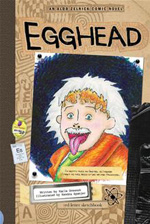 Like many kids, Aldo Zelnick loves science, but he sees no reason to learn Spanish. He forgets that all the A’s on his report card don’t make up for that one D in Spanish. His best friend Jack becomes upset when Aldo denigrates the Spanish language and thinks that speaking English is fine enough for him. Aldo has plenty of things on his mind, especially with Halloween around the corner. Luckily for him, his father takes him to a costume store where he finds a costume of Albert Einstein, his hero. Jack and Aldo are in a race to collect the most candies, but the race loses importance because of the rainy night and the disappearance of Jack’s grandfather. The elderly man, who used to be a scientist, now has Alzheimer’s. In rescuing him, Aldo uses all the Spanish he knows and keeps him safe. Jack is grateful enough to share his rain-soaked candies with Aldo. Filled with many humorous moments, the book is engaging to read and introduces surprising amounts of science information and experiments casually. It is a good example of a writing mentor text with a perfect narrative voice and pictures that tell their own story. A word gallery in English and Spanish at the end of the book lends authenticity to the reading experience. The title might be useful in classroom discussions on diversity and celebrating the cultures represented in the classroom.
Like many kids, Aldo Zelnick loves science, but he sees no reason to learn Spanish. He forgets that all the A’s on his report card don’t make up for that one D in Spanish. His best friend Jack becomes upset when Aldo denigrates the Spanish language and thinks that speaking English is fine enough for him. Aldo has plenty of things on his mind, especially with Halloween around the corner. Luckily for him, his father takes him to a costume store where he finds a costume of Albert Einstein, his hero. Jack and Aldo are in a race to collect the most candies, but the race loses importance because of the rainy night and the disappearance of Jack’s grandfather. The elderly man, who used to be a scientist, now has Alzheimer’s. In rescuing him, Aldo uses all the Spanish he knows and keeps him safe. Jack is grateful enough to share his rain-soaked candies with Aldo. Filled with many humorous moments, the book is engaging to read and introduces surprising amounts of science information and experiments casually. It is a good example of a writing mentor text with a perfect narrative voice and pictures that tell their own story. A word gallery in English and Spanish at the end of the book lends authenticity to the reading experience. The title might be useful in classroom discussions on diversity and celebrating the cultures represented in the classroom.
- Rani Iyer, Washington State University Pullman
Snicket, Lemony. (2012). “Who could that be at this hour?” Illus. by Seth. Boston: Little, Brown and Company Books for Young Readers.
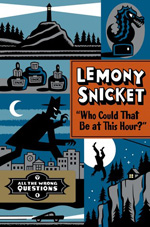 And so begins the new young Lemony Snicket series, “All the Wrong Questions,” the first of four volumes. Young Snicket, nearly 13, is apprenticed to the rather lame-brained S. Theodora Markson who is affiliated with a strange and rather mysterious unnamed organization (though readers of A Series of Unfortunate Events will guess … VFB). What else would readers expect from Snicket (aka author Daniel Handler)? Snicket and Markson have been hired by Mrs. Murphy Sallis to find a valuable missing object, a statue called the Bombinating Beast. Their search takes them to the seaside town, drained of seawater, of Stain’d-by-the-Sea. Though Snicket is on the case, his mind is also on a situation at home. Friends, Moxie and Ellington are trying to help … possibly. In his signature zany writing style, full of literary references, vocabulary and innuendoes, the author has returned readers to the adolescent life of Lemony Snicket in this prequel for the first of this adventure quartet. Teachers will find more back matter at the USA Today interview with the author. Teachers and readers will find many fun “extras” at the publisher website.
And so begins the new young Lemony Snicket series, “All the Wrong Questions,” the first of four volumes. Young Snicket, nearly 13, is apprenticed to the rather lame-brained S. Theodora Markson who is affiliated with a strange and rather mysterious unnamed organization (though readers of A Series of Unfortunate Events will guess … VFB). What else would readers expect from Snicket (aka author Daniel Handler)? Snicket and Markson have been hired by Mrs. Murphy Sallis to find a valuable missing object, a statue called the Bombinating Beast. Their search takes them to the seaside town, drained of seawater, of Stain’d-by-the-Sea. Though Snicket is on the case, his mind is also on a situation at home. Friends, Moxie and Ellington are trying to help … possibly. In his signature zany writing style, full of literary references, vocabulary and innuendoes, the author has returned readers to the adolescent life of Lemony Snicket in this prequel for the first of this adventure quartet. Teachers will find more back matter at the USA Today interview with the author. Teachers and readers will find many fun “extras” at the publisher website.
- Karen Hildebrand, Ohio Library and Reading Consultant
Swindells, Robert. (2012). Trick or treat. Minneapolis: Lerner/Stoke Books.
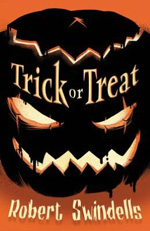 Like many teens, Harley Davidson has no intention to haul his younger siblings from door to door in search of candy on Halloween. After all, there’s a school dance that night, for which he plans to don his authentic Dracula costume in order to impress Uma Broom, a girl on whom he has a crush. But when his mother refuses to compromise, he finds himself walking along the sidewalk with his brother and sister. Along the way, some sort of evil spirit in the form of a white piece of cloth distracts him from watching the children. He follows the whiteness until it seems to become a dress worn by Uma, who seems to beckon him across the street to a nearby pond where she skims along the water. By the time he returns to his young charges, they have seemingly disappeared. When he finds them, they are no longer interested in treats but are bullying a neighbor who refused to give them candy earlier. Who are these children? Although the ending comes too abruptly, readers will relish the creepiness and open-endedness of this very short story, and reflect upon how hard it is to explain some of the things that happen in the world. Read in the right way with the right types of voices and emphasis, this title could be a fine Halloween read aloud that just might scare the dickens out of its hearers.
Like many teens, Harley Davidson has no intention to haul his younger siblings from door to door in search of candy on Halloween. After all, there’s a school dance that night, for which he plans to don his authentic Dracula costume in order to impress Uma Broom, a girl on whom he has a crush. But when his mother refuses to compromise, he finds himself walking along the sidewalk with his brother and sister. Along the way, some sort of evil spirit in the form of a white piece of cloth distracts him from watching the children. He follows the whiteness until it seems to become a dress worn by Uma, who seems to beckon him across the street to a nearby pond where she skims along the water. By the time he returns to his young charges, they have seemingly disappeared. When he finds them, they are no longer interested in treats but are bullying a neighbor who refused to give them candy earlier. Who are these children? Although the ending comes too abruptly, readers will relish the creepiness and open-endedness of this very short story, and reflect upon how hard it is to explain some of the things that happen in the world. Read in the right way with the right types of voices and emphasis, this title could be a fine Halloween read aloud that just might scare the dickens out of its hearers.
- Barbara A. Ward, Washington State University Pullman
GRADES 5-8
Gallagher, Diana. (2012). Haunted love. Mankato, MN: Stone Arch Books/Capstone Imprint.
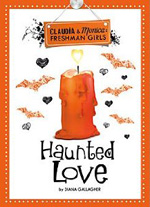 From the Claudia & Monica: Freshman Girls series, this quick novel will provide an interesting seasonal read for reluctant middle grade readers who like a bit of romance and high school friend drama. Claudia and Monica take turns narrating the chapters as they comment on life in high school from friends, to friends who become boyfriends, to high school parties and shopping. This episode in the series centers around Halloween parties, the two girls feuding over boys, new high school friendships, and the draw of the popular “in” crowd and deciding whom your real friends are. Use this time of year to study a classic that ReadWriteThink has explored, “A Directed Listening-Thinking Activity for ‘The Tell-Tale Heart.”
From the Claudia & Monica: Freshman Girls series, this quick novel will provide an interesting seasonal read for reluctant middle grade readers who like a bit of romance and high school friend drama. Claudia and Monica take turns narrating the chapters as they comment on life in high school from friends, to friends who become boyfriends, to high school parties and shopping. This episode in the series centers around Halloween parties, the two girls feuding over boys, new high school friendships, and the draw of the popular “in” crowd and deciding whom your real friends are. Use this time of year to study a classic that ReadWriteThink has explored, “A Directed Listening-Thinking Activity for ‘The Tell-Tale Heart.”
- Karen Hildebrand, Ohio Library and Reading Consultant
Valente, Catherynne. (2012). The girl who fell beneath Fairyland and led the revels there. Illus. by Ana Juan. New York: Feiwel and Friends/Macmillan Publishing Group.
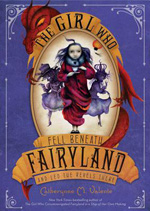 Hugo award-winning author Cat Valente returns to Fairyland from her popular first book, The Girl Who Circumnavigated Fairyland in a Ship of Her Own Making (2011). A year after the first adventure, September is now 13 and leaves her home in Nebraska to journey back to Fairyland. When she arrives, she quickly discovers things are not as she left them. Shadows have been stolen and everyone is living in fear, especially of the gruesome Alleyman who is the stealer of shadows. September learns that the shadows and the magic that goes with them are being sent to Fairyland Below and it is her very own shadow, Halloween, who is orchestrating the descent and despair among Fairyland Above. September is determined to set things right and plunges down into the darkness and depths of Halloween’s reign of terror. Though a few old friends appear in the story like Saturday and Wyverary, many new characters appear to join September on this dangerous quest to recover the missing shadows. Her goal is to awaken the Sleeping Prince and join forces against Halloween’s evil. Readers will find this sequel a darker and more grief filled volume than the first story of September and Fairyland. Teachers and readers will find a book trailer available at the publisher’s website or learn more about this versatile author at her website.
Hugo award-winning author Cat Valente returns to Fairyland from her popular first book, The Girl Who Circumnavigated Fairyland in a Ship of Her Own Making (2011). A year after the first adventure, September is now 13 and leaves her home in Nebraska to journey back to Fairyland. When she arrives, she quickly discovers things are not as she left them. Shadows have been stolen and everyone is living in fear, especially of the gruesome Alleyman who is the stealer of shadows. September learns that the shadows and the magic that goes with them are being sent to Fairyland Below and it is her very own shadow, Halloween, who is orchestrating the descent and despair among Fairyland Above. September is determined to set things right and plunges down into the darkness and depths of Halloween’s reign of terror. Though a few old friends appear in the story like Saturday and Wyverary, many new characters appear to join September on this dangerous quest to recover the missing shadows. Her goal is to awaken the Sleeping Prince and join forces against Halloween’s evil. Readers will find this sequel a darker and more grief filled volume than the first story of September and Fairyland. Teachers and readers will find a book trailer available at the publisher’s website or learn more about this versatile author at her website.
- Karen Hildebrand, Ohio Library and Reading Consultant
GRADES 7-12
Castellucci, Cecil. (2012). The year of the beasts. Illus. by Nate Powell. New York: Macmillan/Roaring Brook Press.
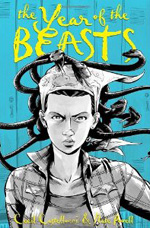 Partly because of the closeness in their ages, siblings Tessa, 15, and Lulu, 13, have always been close. But their closeness becomes a thing of the past after the girls go to a carnival without their parents. The merriment turns to sourness once things take an unexpected turn. When a romance blossoms between Lulu and Charlie, the boy on whom Tessa has designs, Tessa feels betrayed and left out. Although Tessa has her own admirer and a secret romance with Jasper, a neighbor considered a misfit by his peers, she cannot control the anger and jealousy that seethe through her every time she sees her sister or hears about Charlie. Having Jasper is not enough, and she is embarrassed to admit her attraction to Jasper. Even when Lulu apologizes for dating Charlie, Tessa is unable to forgive her sister, and her anger leads to tragedy. Alternating with this story is a graphic novel that shows Tessa as Medusa, snake heads writhing above her head, turning those around her to stone. Readers will enjoy trying to decide whether the book contains two separate stories or one story with different elements and perspectives. A cautionary tale, the story serves as a vivid reminder of how self-destructive jealousy and hatred can be. Tessa is so intent on having what her sister has that she loses sight of her own boyfriend and her love for her sister. There’s nothing more frightening than that, as this creative endeavor demonstrates.
Partly because of the closeness in their ages, siblings Tessa, 15, and Lulu, 13, have always been close. But their closeness becomes a thing of the past after the girls go to a carnival without their parents. The merriment turns to sourness once things take an unexpected turn. When a romance blossoms between Lulu and Charlie, the boy on whom Tessa has designs, Tessa feels betrayed and left out. Although Tessa has her own admirer and a secret romance with Jasper, a neighbor considered a misfit by his peers, she cannot control the anger and jealousy that seethe through her every time she sees her sister or hears about Charlie. Having Jasper is not enough, and she is embarrassed to admit her attraction to Jasper. Even when Lulu apologizes for dating Charlie, Tessa is unable to forgive her sister, and her anger leads to tragedy. Alternating with this story is a graphic novel that shows Tessa as Medusa, snake heads writhing above her head, turning those around her to stone. Readers will enjoy trying to decide whether the book contains two separate stories or one story with different elements and perspectives. A cautionary tale, the story serves as a vivid reminder of how self-destructive jealousy and hatred can be. Tessa is so intent on having what her sister has that she loses sight of her own boyfriend and her love for her sister. There’s nothing more frightening than that, as this creative endeavor demonstrates.
- Barbara A. Ward, Washington State University Pullman
Ellen, Laura. (2012). Blind spot. New York: Harcourt Children’s Books.
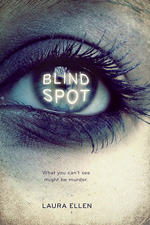 Sixteen-year-old protagonist Roz learns that she has macular degeneration, making it hard for her to see the world around her. Not only that, but she has difficulty in deciding who is trustworthy, making her have a blind spot when it comes to the wrong individuals. The book starts out promisingly—and chillingly—with the discovery of the body of her troubled classmate, Tricia Farni, revealed as the ice and snow begin to melt. What caused her to die? That's the central question in the novel, one that is never really answered although several possibilities are shared. The fact that Roz is unable to see clearly and then seemingly has lost her memory of a crucial night in her life creates a mystery for readers and throws suspicion for Tricia's death on various individuals, including Roz. The plot is filled with familiar elements that add to the story’s realism, including high school jealousy, unreliable boyfriends, unfair teachers bent on teaching lessons to those who rebel against them, and a main character unable to decide what she wants. Adding to the creepiness, the book's secondary characters are completely unreliable, and friendships and alliances are formed and dissolved rapidly. Even Roz's boyfriend is hard to pin down. In some respects, he seems like a good guy, especially near the book's beginning, but is he? Teen readers will enjoy trying to sort out all the clues in solving this murder mystery and gain a clear perspective on the emotional drama of high school relationships when merely getting through the day is a high-stakes matter.
Sixteen-year-old protagonist Roz learns that she has macular degeneration, making it hard for her to see the world around her. Not only that, but she has difficulty in deciding who is trustworthy, making her have a blind spot when it comes to the wrong individuals. The book starts out promisingly—and chillingly—with the discovery of the body of her troubled classmate, Tricia Farni, revealed as the ice and snow begin to melt. What caused her to die? That's the central question in the novel, one that is never really answered although several possibilities are shared. The fact that Roz is unable to see clearly and then seemingly has lost her memory of a crucial night in her life creates a mystery for readers and throws suspicion for Tricia's death on various individuals, including Roz. The plot is filled with familiar elements that add to the story’s realism, including high school jealousy, unreliable boyfriends, unfair teachers bent on teaching lessons to those who rebel against them, and a main character unable to decide what she wants. Adding to the creepiness, the book's secondary characters are completely unreliable, and friendships and alliances are formed and dissolved rapidly. Even Roz's boyfriend is hard to pin down. In some respects, he seems like a good guy, especially near the book's beginning, but is he? Teen readers will enjoy trying to sort out all the clues in solving this murder mystery and gain a clear perspective on the emotional drama of high school relationships when merely getting through the day is a high-stakes matter.
- Barbara A. Ward, Washington State University Pullman
Hubbard, Mandy. (2012). Dangerous boy. New York: Penguin/Razorbill.
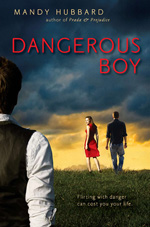 Improbably, quiet Harper Bennett has caught the attention of Logan Townsend, the handsome new boy in town. At first she’s filled with bliss because of the budding romance, but the secrets she learns about Logan and his twin brother leave her disoriented. Because the book opens with a scene showing Harper running for her life and then shifts back to Harper's happy times with Logan, readers are unable to gauge at first how the relationship began. In many ways, Logan seems to be a great guy, thoughtful and considerate. But there are hints about what's going on when he becomes troubled during thunder storms or when Harper encounters his twin brother, Daemon, in a creepy basement scene set in the crumbling mansion owned by the boys' uncle who is always on business trips. Restricted by fears that keep her from living life to its fullest as the result of her mother's death, Harper is a bundle of nerves in some respects and has a list of activities she avoids. Teen readers will enjoy watching Harper take chances while trying to figure out the truth about the boy to whom she has lost her heart. For Harper, though, falling in love may result in losing her life.
Improbably, quiet Harper Bennett has caught the attention of Logan Townsend, the handsome new boy in town. At first she’s filled with bliss because of the budding romance, but the secrets she learns about Logan and his twin brother leave her disoriented. Because the book opens with a scene showing Harper running for her life and then shifts back to Harper's happy times with Logan, readers are unable to gauge at first how the relationship began. In many ways, Logan seems to be a great guy, thoughtful and considerate. But there are hints about what's going on when he becomes troubled during thunder storms or when Harper encounters his twin brother, Daemon, in a creepy basement scene set in the crumbling mansion owned by the boys' uncle who is always on business trips. Restricted by fears that keep her from living life to its fullest as the result of her mother's death, Harper is a bundle of nerves in some respects and has a list of activities she avoids. Teen readers will enjoy watching Harper take chances while trying to figure out the truth about the boy to whom she has lost her heart. For Harper, though, falling in love may result in losing her life.
- Barbara A. Ward, Washington State University Pullman
Shan, Darren. (2012). Zom-B. New York: Simon & Schuster.
 Londoner B lives with her abusive, racist father and her ever-patient mother. Mingled rage and shame seethe inside B, leaving her torn between doing what's right and pleasing her father. He blames the country's problems on its many immigrants while she has friends on whom he might not look too kindly. As the novel opens, the two laugh at news reports of zombies in a small Irish village, but the amusement turns to stark-raving terror on B’s part once zombies enter her high school, biting the students and teachers and eating their brains. At first, B and some of her friends manage to avoid the bloodshed, leaving other friends behind, only to find that the schools’ exits have been blocked. Somehow, B's father arrives to rescue her, but she feels ashamed at having betrayed her companions, even throwing one dark-skinned boy into the zombies' clutches. Although she hates her father for his attitude toward anyone different from him, B also recognizes that she is more like him than she wants to be. The book is fast-paced, drenched with blood and gore and gleeful descriptions of brain consumption. Readers will race through the book with relish, only to find that the story will continue in a future volume. There are plenty of unanswered questions about the individuals in hoods in the cafeteria, the strange friend of B’s father, her own nightmares, and what caused this zombie invasion. Those with weak stomachs might want to avoid the descriptive passages of zombies munching on humans.
Londoner B lives with her abusive, racist father and her ever-patient mother. Mingled rage and shame seethe inside B, leaving her torn between doing what's right and pleasing her father. He blames the country's problems on its many immigrants while she has friends on whom he might not look too kindly. As the novel opens, the two laugh at news reports of zombies in a small Irish village, but the amusement turns to stark-raving terror on B’s part once zombies enter her high school, biting the students and teachers and eating their brains. At first, B and some of her friends manage to avoid the bloodshed, leaving other friends behind, only to find that the schools’ exits have been blocked. Somehow, B's father arrives to rescue her, but she feels ashamed at having betrayed her companions, even throwing one dark-skinned boy into the zombies' clutches. Although she hates her father for his attitude toward anyone different from him, B also recognizes that she is more like him than she wants to be. The book is fast-paced, drenched with blood and gore and gleeful descriptions of brain consumption. Readers will race through the book with relish, only to find that the story will continue in a future volume. There are plenty of unanswered questions about the individuals in hoods in the cafeteria, the strange friend of B’s father, her own nightmares, and what caused this zombie invasion. Those with weak stomachs might want to avoid the descriptive passages of zombies munching on humans.
- Barbara A. Ward, Washington State University Pullman
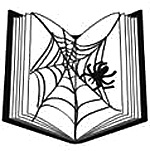
These reviews are submitted by members of the International Reading Association's Children's Literature and Reading Special Interest Group (CL/R SIG) and are published weekly on Reading Today Online.
The International Reading Association partners with the National Council of Teachers of English and Verizon Thinkfinity to produce ReadWriteThink.org, a website devoted to providing literacy instruction and interactive resources for grades K–12.